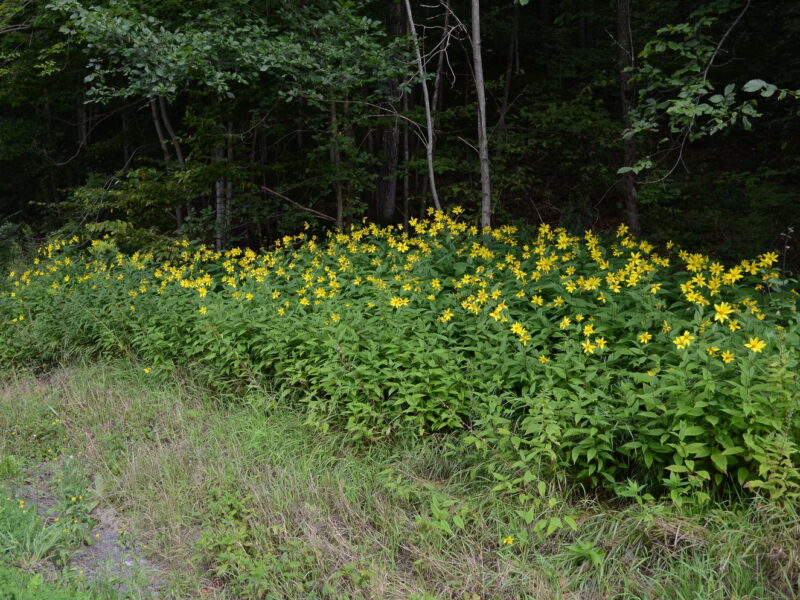

I knew there was something special about the perennial sunflower because I’ve been growing it for years. It makes a wonderful summer hedge as it fills out with bright, sunny, but smaller sunflower flowers, and late in the fall the birds love to harvest the seeds.
Then I got an email from Hudson Valley Seed that reminded me that this plant is much more than a nice, native wildflower. It’s also a sunchoke, also known as the Jerusalem artichoke. And yet, it has no relationship to either Jerusalem or the artichoke.
The confusion doesn’t stop there though because the true hardy sunflower is often confused with another plant, Heliopsis, which is a more ornamental, shorter-lived perennial that, while a “nicer” plant, is lacking many of the traits of the true native sunflower, which seems to be a better choice for those wanting to add pollinator plants to their landscape as well as being a verified native that attracts native bees.
Helianthus tuberosa, commonly known as the sunchoke, sunroot and perennial sunflower is mostly known by its common name, the Jerusalem artichoke. Problem here though is that it has no relationship to Jerusalem, and it isn’t an artichoke. This plant is a true North American native that was used for a number of purposes, but mostly as food, by the Native Americans.
In 1805 Lewis and Clark dined on the plant’s tubers as they were prepared by a Native American woman, and there are earlier references that in 1605, Native Americans fed the root to French explorer Samuel de Champlain, who noted that the flavor reminded him of artichokes.
As for the “Jerusalem,” it’s been noted that the common name seems to be a corruption of the Italian girasole, which is translated as “turning to the sun” but along the way became “Jerusalem.” Bottom line though is that this plant has no relationship to the city and no relationship to the true artichoke.
The tuber of the plant is used by cooks in several ways, including being mashed, roasted, boiled and fried with the taste often being compared to that of the nutty flavor of water chestnuts. But if you have an issue with flatulence, the presence of inulin, a nondigestible fiber, may be an indication that you go easy with the edible portion of the plant.
In the landscape H. tuberosa is best suited to isolated spots where it can be left to sprawl. It grows from 6 to 8 feet tall and flowers with 2-inch yellow flowers in late summer. The understory of the plant can be home to wildlife while the flowers will attract a range of pollinators followed by the birds that will feast on the small sunflower seeds toward the end of the season. In wild areas of your property the plant can simply be left to self compost at the end of the season but in more formal settings it should be cut down late in the fall or late in winter.
One of the downsides of this perennial sunflower is that it spreads. While it may pop up in other areas from seeds moved around by animals and birds the plant really spreads by its ever expanding tubers. In the wild it can be found in such diverse settings as stream sides to wastelands. It’s actually pretty adaptable as long as it gets its namesake — sun — and doesn’t have wet feet.
My suggestion is that you plant this native in a spot by its own where you can manage it if necessary. You can buy the tubers from a number of online vendors, and they are generally planted in early spring or late in the fall when the plants are dormant. Plant the tubers 4 inches below the soil surface and simply water in. As with other tubers make sure the “eyes” are pointed upward. Depending on the size of the tubers you plant you may get flowers in the late summer and if not, the following summer. Diseases and insects are rarely if ever a problem though slugs and snails may dine on the foliage in wet plantings.
For those wanting to take advantage of the culinary aspects of the tubers, you’ll do your harvesting in the fall through spring, and the harvested tubers will store in a dry, cool and dark spot for about two months similar to potatoes. Good companion plants are noted to be corn and rhubarb, but the tubers should not be planted near tomatoes.
There seem to be several varieties of sunchoke that interest cooks. Red Fuseau has a red tuber with what’s noted as a crunchy, sweet flavor as well as thin skins that make them easy to clean. The plants are very dense and may grow 8 to 10 feet tall. White Fuseau seems to have similar characteristics with both the white and red having a smoky flavor. Also a white is one marketed as “French Mammoth White,” and “Golden Nugget” is noted as having a more tapered root, smooth flavor and being easy to slice.
For those wanting to explore further, Oilos Tree Crops (tinyurl.com/yn2y9w7d) offers a seed variety called Shiawasse that has long slender tubers growing to 12 inches, but it’s noted as being a short-season crop. There are also notes about seven other varieties that they offer tubers of.
Hudson Valley Seed Company offered two varieties but within a few days of them appearing on their online catalog they were sold out. But there may be more available so check them out. Territorial Seed sells the plants in 3-and-a-half-inch pots at tinyurl.com/yb7z4rct.
If you’re planting tubers for food production as opposed to flower production you can prune the plants down to 4 feet tall in mid-summer. This results in more and larger tubers but fewer flowers on shorter plants. Space you production tubers about 12 to 18 inches apart, and tubers shorter than an inch and three quarters long may not be productive.
Again, keep in mind that this is a perennial that tends to spread and sprawl. While it is an active grower it can be managed and is not considered an invasive in the East, but some may argue that. If you have friends or neighbors with this plant they may give you a tuber or two and that’s an easy way to begin your planting. Keep in mind that they turn into tall and often dense plantings making good summer screening but not a flower patch that you’ll want to see among your formal gardens and other perennials.
If this tuberous, perennial sunflower doesn’t ring your bell there are several other perennial sunflowers you might be interested in, but none with tubers and they may not be natives. These include the species H. mollis (downy sunflower), H. grosseserratus (saw-tooth sunflower), H. maximiliani (maximilian’s sunflower), H. giganteus (tall sunflower) and H. occidentalis (western sunflower) which grows well in very sandy soils. Seeds and descriptions of these are found at prairiemoon.com. Keep growing.
 More Posts from Andrew Messinger
More Posts from Andrew Messinger